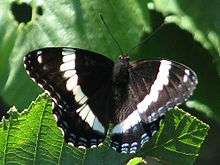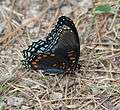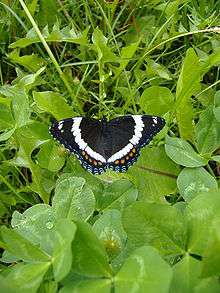Limenitis arthemis
| White admiral | |
|---|---|
| | |
| L. a. astyanax | |
 | |
| L. a. arthemis | |
| Not evaluated (IUCN 3.1) | |
| Scientific classification | |
| Kingdom: | Animalia |
| Phylum: | Arthropoda |
| Class: | Insecta |
| Order: | Lepidoptera |
| Family: | Nymphalidae |
| Genus: | Limenitis |
| Species: | L. arthemis |
| Binomial name | |
| Limenitis arthemis (Drury, 1773) | |
| Synonyms | |
|
Basilarchia arthemis | |
The white admiral or red-spotted purple (Limenitis arthemis) is a polytypic species of North American brush-footed butterfly, common throughout much of the eastern United States. L. a. astyanax has red spots on its underside and the top of the wings are notable for their iridescent blue markings. L. a. arthemis on the other hand has a large white band traversing both the forewings and hindwings.
The red-spotted purple is a mimic of the poisonous pipevine swallowtail (Battus philenor) and is typically found in open woodlands and along forest edges and roadsides.
Subspecies
Four subspecies of the butterfly are known:
- Limenitis arthemis arthemis – (American) white admiral (see also Limenitis camilla)
- Limenitis arthemis rubrofasciata – western (American) white admiral, characterised by the absence of blue spots on its hindwings
- Limenitis arthemis astyanax – red-spotted purple or red-spotted admiral, no white bands on wings
- Limenitis arthemis arizonensis – Arizona red-spotted purple,[1] it has no white bands on wings
Description
Both sexes of this species are identical except that the females are slightly larger than the males.[2] The upperside of L. a. arthemis is mostly blackish-blue with white postmedian bands across both wings. Some individuals have a row of red submarginal spots, while others have this area being blue. The underside of the wings is a blackish color with a broad white postmedian band. The basal area of both wings contains many red spots. The submarginal area may contain a row of red spots and the marginal area having bluish spots. However, sometimes the submarginal and marginal areas are just a reddish-brown color.[2][3][4]
The upperside of L. a. astyanax is very much like L. a. arthemis except it lacks the broad white bands. The forewing submarginal area will sometimes have a row of red spots. The hindwings are either a bright iridescent blue or an iridescent bluish-green. The underside of the wings lacks the white band. The basal area has several red spots. It has a row of red submarginal spots and bluish marginal spots.[2][3]
L. a. arizonensis is indistinguishable from L. a. astyanax except that L. a. arizonensis is found in the southwest and its range does not overlap the range of L. a. astyanax.[3][5]
Intermediates between L. a. arthemis and L. a. astyanax can occur. L. a. arthemis f. proserpina has faint white bands. L. a. arthemis f. albofaciata has more conspicuous white bands but they are not as broad as the bands are on L. a. arthemis.[2][4]
Ecology
Preferred host plants: birches, including Betula lenta; Salicaceae, including Salix bebbiana and Populus tremuloides, and Prunus virginiana (Rosaceae).
Also but not as often: Crataegus, Amelanchier, Malus pumila, Prunus pensylvanica and Prunus serotina (Rosaceae), Populus deltoides, P. grandidentata and P. balsamifera (Salicaceae), Alnus rugosa, Betula alleghaniensis and Carpinus caroliniana (Betulaceae), Ulmus americana (Ulmaceae), Tilia americana (Malvaceae) and Fagus grandifolia (Fagaceae).
Adults are diurnal, they fly from the morning until soon after dusk (Fullard & Napoleone 2001).
Etymology
Limenitis (New Latin "of harbours", from Ancient Greek Λιμενιτις (from λιμήν, a harbour, haven) – an epithet of Artemis, goddess of the hunt and the wild) – arthemis, from Artemis.[6]
Image gallery
 Side view of Limenitis arthemis astyanax, Hot Springs National Park, Arkansas, United States
Side view of Limenitis arthemis astyanax, Hot Springs National Park, Arkansas, United States Back view of Limenitis arthemis astyanax, Hot Springs National Park, Arkansas, United States
Back view of Limenitis arthemis astyanax, Hot Springs National Park, Arkansas, United States White admiral in southern Maine
White admiral in southern Maine Red-spotted purple (Limenitis arthemis astyanax), Baltimore, Maryland, United States
Red-spotted purple (Limenitis arthemis astyanax), Baltimore, Maryland, United States Limenitis arthemis arthemis, New Brunswick, Canada
Limenitis arthemis arthemis, New Brunswick, Canada White admiral in Saskatoon, Saskatchewan, Canada
White admiral in Saskatoon, Saskatchewan, Canada Red-spotted purple (Limenitis arthemis astyanax), York, Pennsylvania, United States
Red-spotted purple (Limenitis arthemis astyanax), York, Pennsylvania, United States Limenitis arthemis arthemis, dorsal, Ottawa, Ontario
Limenitis arthemis arthemis, dorsal, Ottawa, Ontario Limenitis arthemis arthemis, ventral, Ottawa, Ontario
Limenitis arthemis arthemis, ventral, Ottawa, Ontario Caterpillar
Caterpillar- Limenitis arthemis arthemis, Quebec
In popular culture
The white admiral (Limenitis arthemis arthemis) is, since a poll in October 1998, the (unofficial) insect emblem of the province of Quebec, Canada. (See Quebec symbols and emblems for further details). It is the only sub-species of Limenitis arthemis present in Quebec.
References
- Darby, Gene (1958). What is a Butterfly. Chicago: Benefic Press. p. 37.
- Fullard, James H. & Napoleone, Nadia (2001): Diel flight periodicity and the evolution of auditory defences in the Macrolepidoptera. Animal Behaviour 62(2): 349–368. doi:10.1006/anbe.2001.1753 PDF fulltext
- Handfield, Louis (1999): Papillons du Québec. Broquet. ISBN 2-89000-486-4
Footnotes
- ↑ Arizona red-spotted purple, BugGuide
- 1 2 3 4 Rick Cech and Guy Tudor (2005). Butterflies of the East Coast. Princeton University Press, Princeton, NJ. ISBN 0-691-09055-6
- 1 2 3 Jim P. Brock and Kenn Kaufman (2003). Butterflies of North America. Houghton Mifflin, New York, NY. ISBN 0-618-15312-8
- 1 2 David C. Iftner, John A. Shuey, and John V. Calhoun (1992). Butterflies and Skippers of Ohio. College of Biological Sciences and The Ohio State University. ISBN 0-86727-107-8
- ↑ Bob Stewart, Priscilla Brodkin and Hank Brodkin (2001). Butterflies of Arizona. West Coast Lady Press. ISBN 0-9663072-1-6
- ↑ The Century Dictionary by The Century Company. Available online at dictionary.com/index.html.
External links
| Wikimedia Commons has media related to Limenitis arthemis. |
| Wikispecies has information related to: Limenitis arthemis |
| External identifiers for Limenitis arthemis | |
|---|---|
| Encyclopedia of Life | 162156 |
| Also found in: Wikispecies | |
- Red-Spotted Purple: Reference large format diagnostic photographs from Cirrus Digital Imaging
- White Admiral
- Life cycle with photographs of the red-spotted purple (Limenitis arthemis astyanax).
- Pictures of the different subspecies from *Discover Life.
- Limenitis arthemis at Animal Diversity Web
- red-spotted purple on the UF / IFAS Featured Creatures Web site
- White Admiral, Red-spotted Purple, Butterflies of Canada
| Wikispecies has information related to: Lepidoptera |
| The Wikibook Dichotomous Key has a page on the topic of: Lepidoptera |
